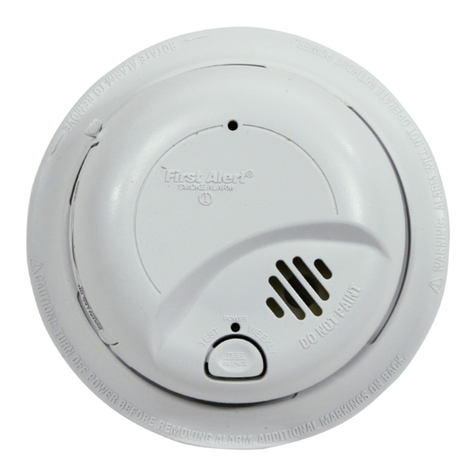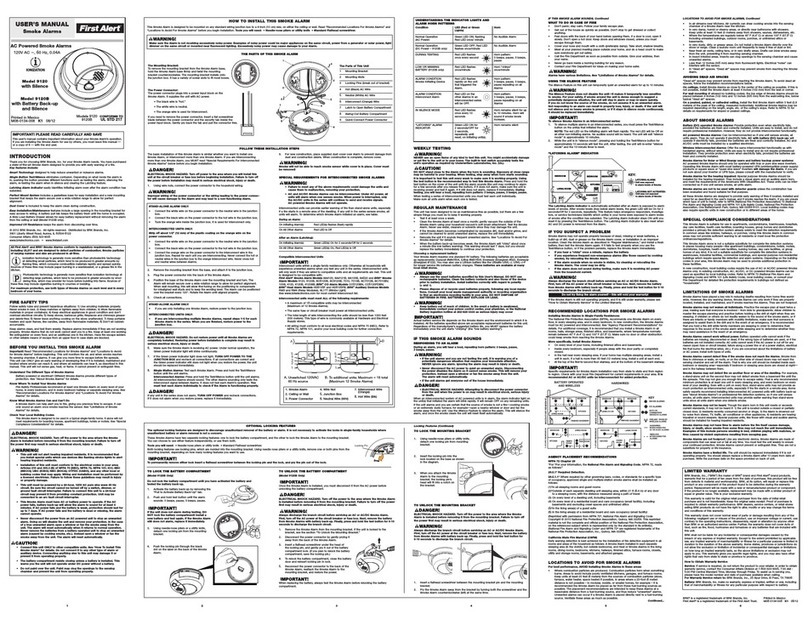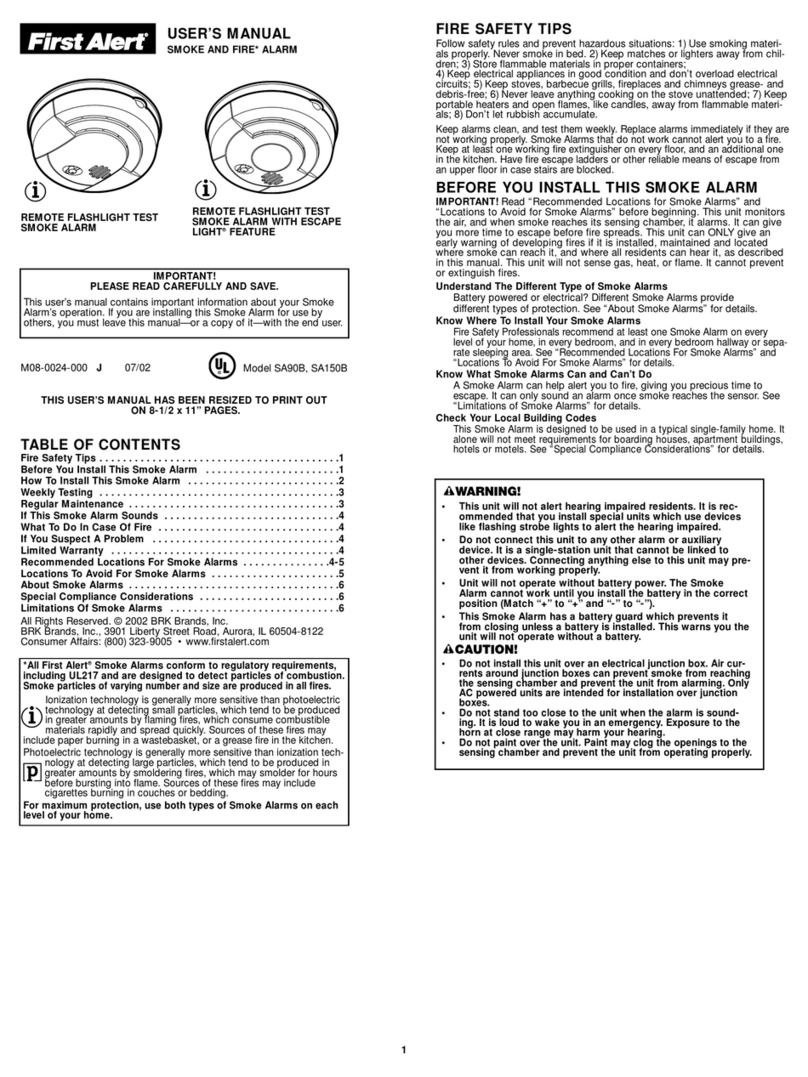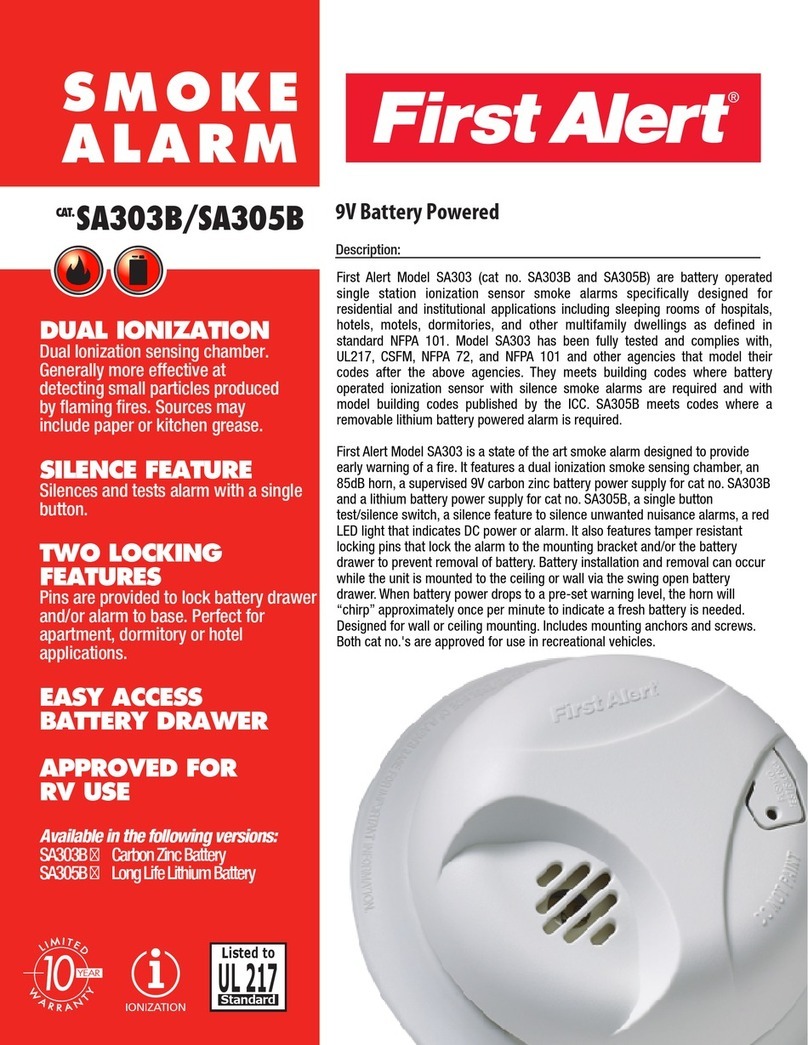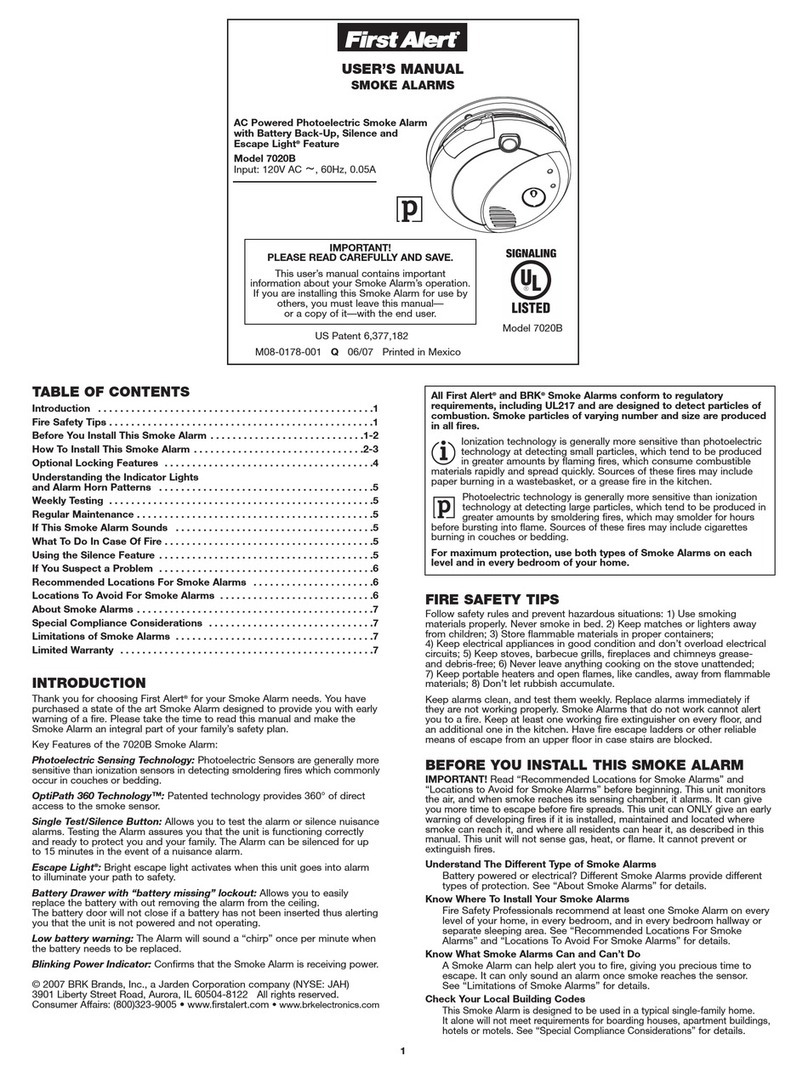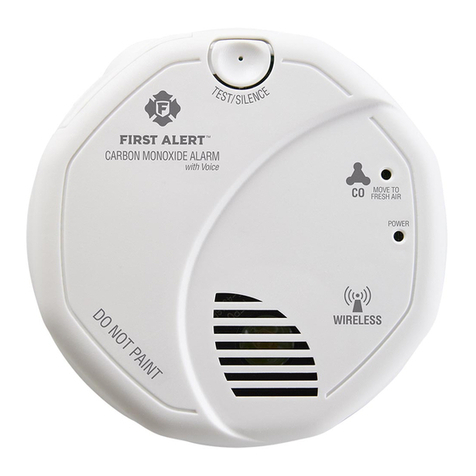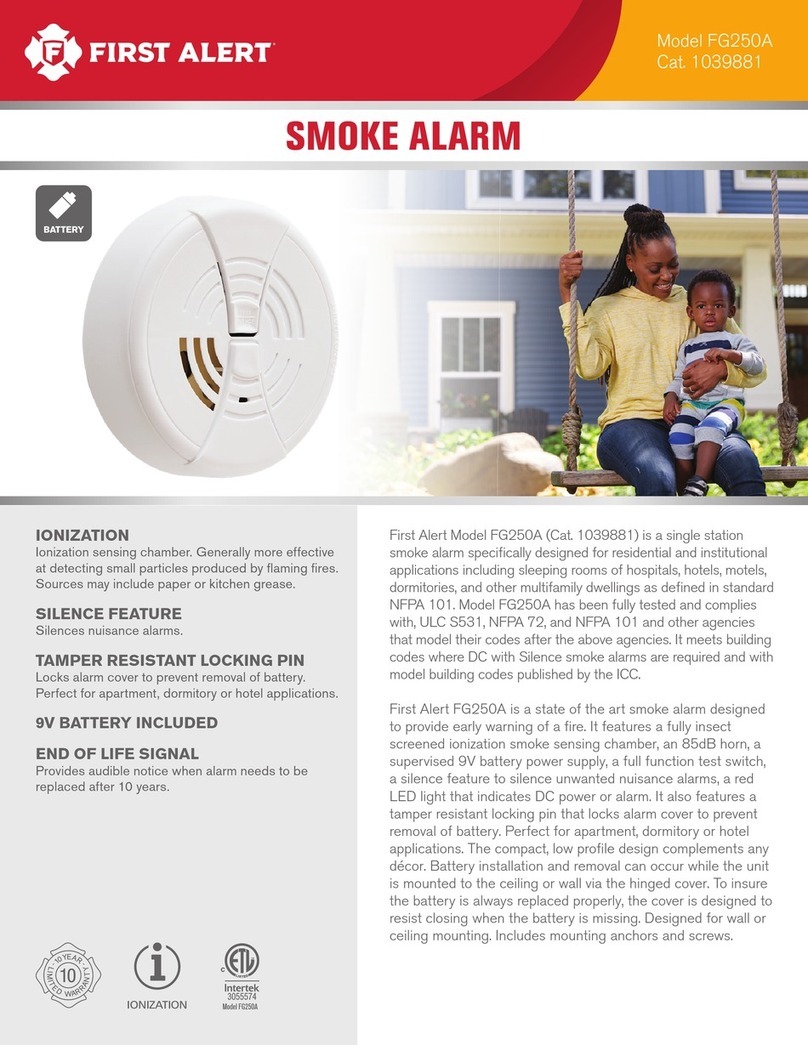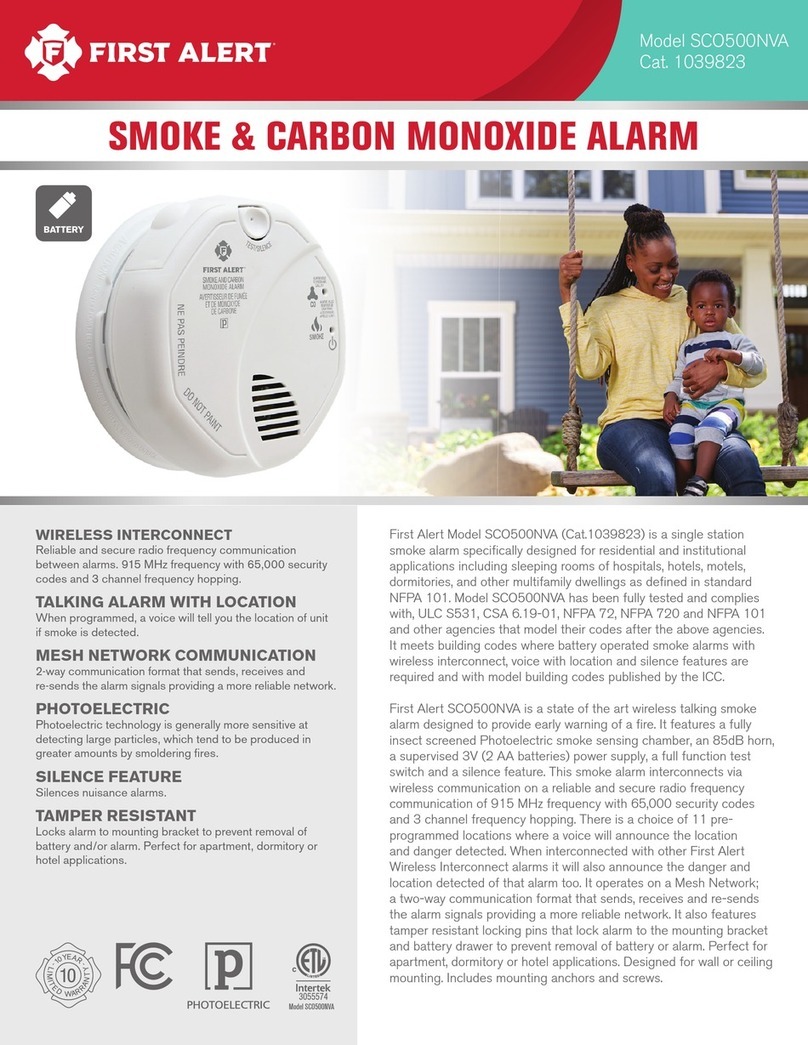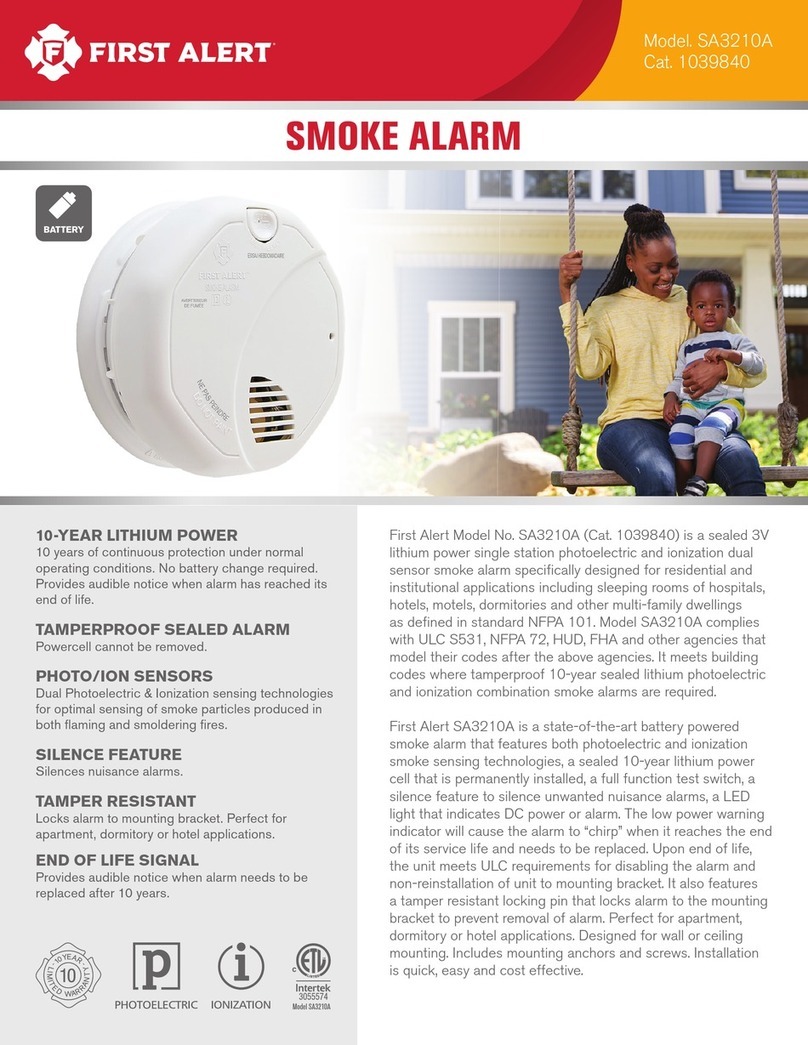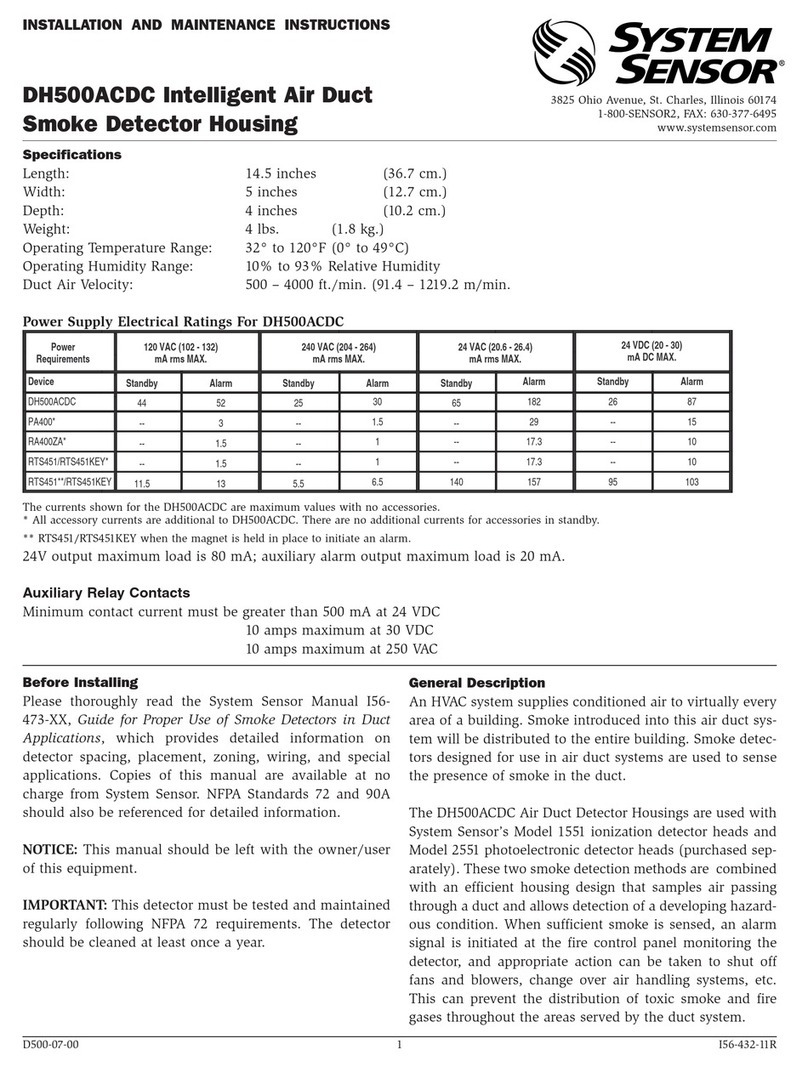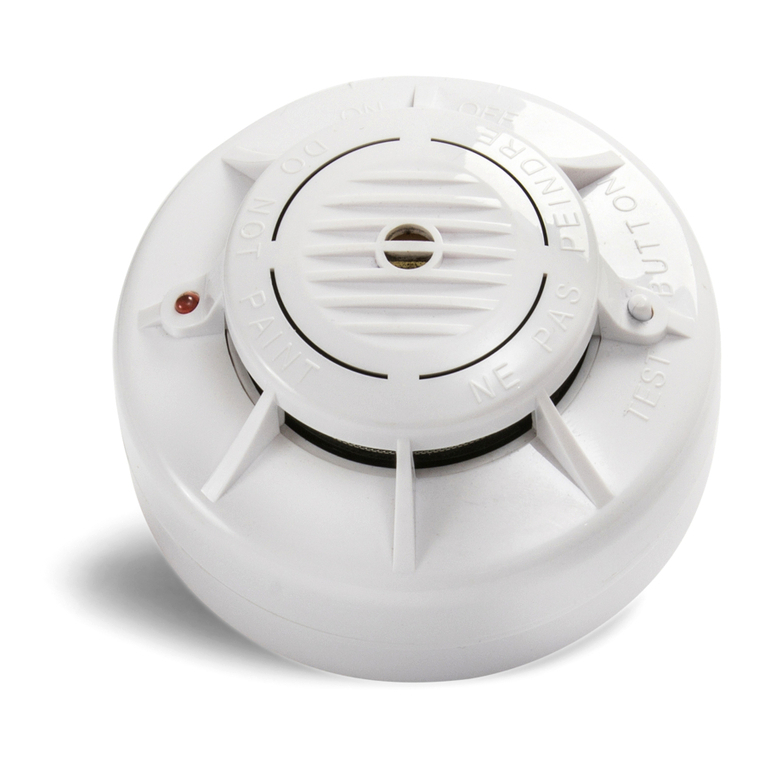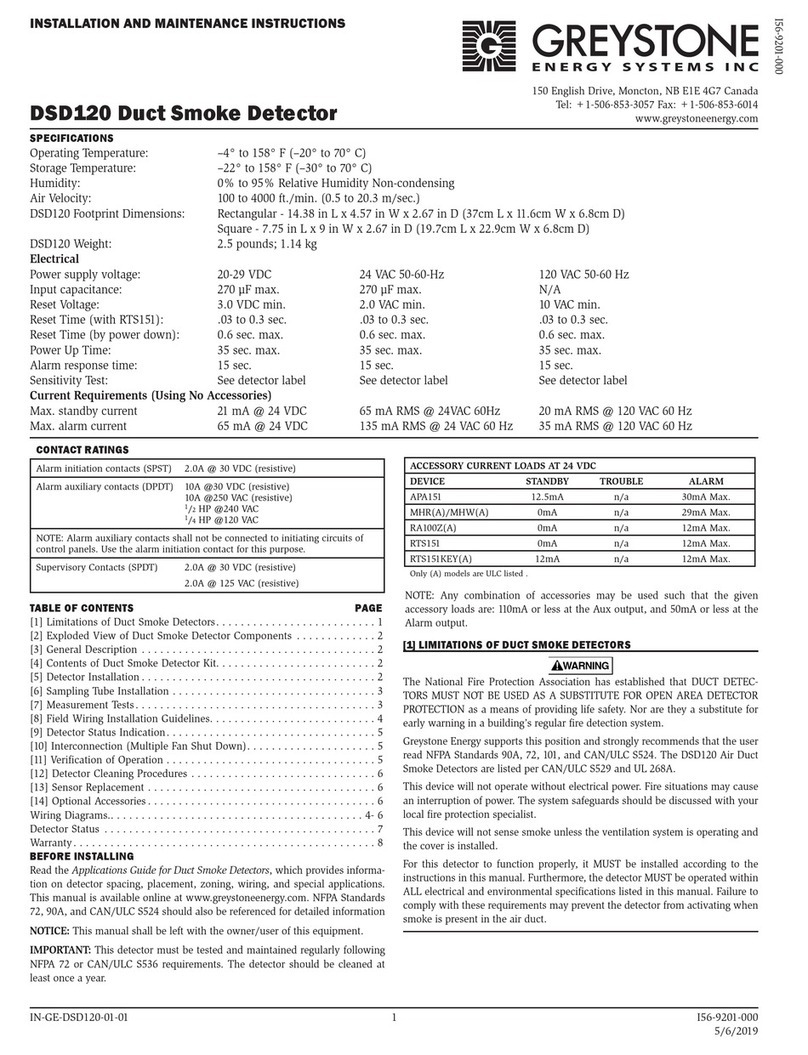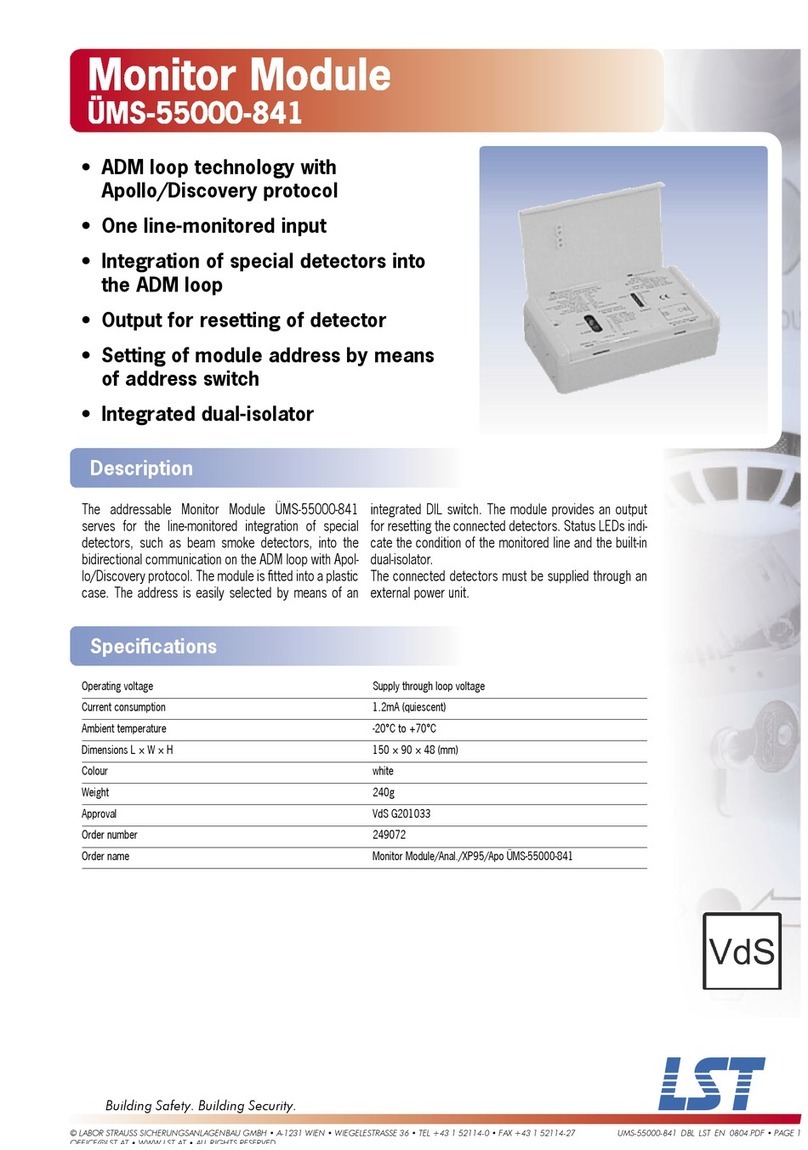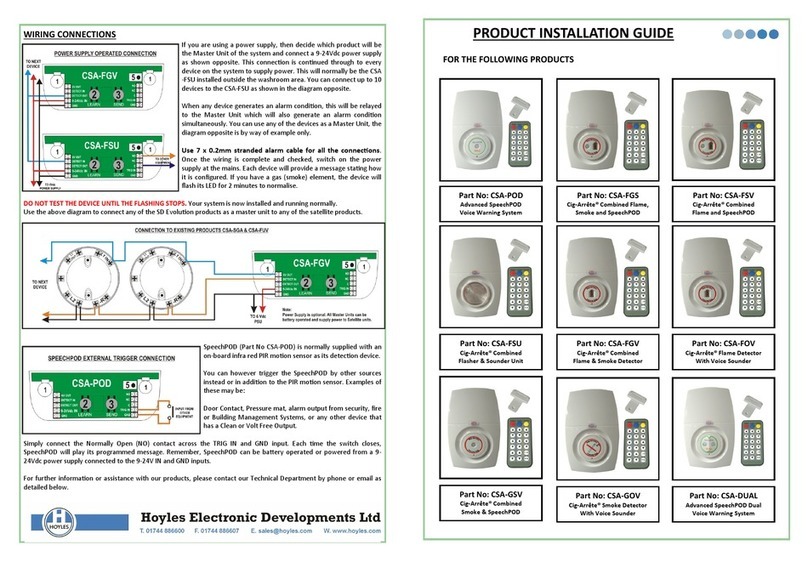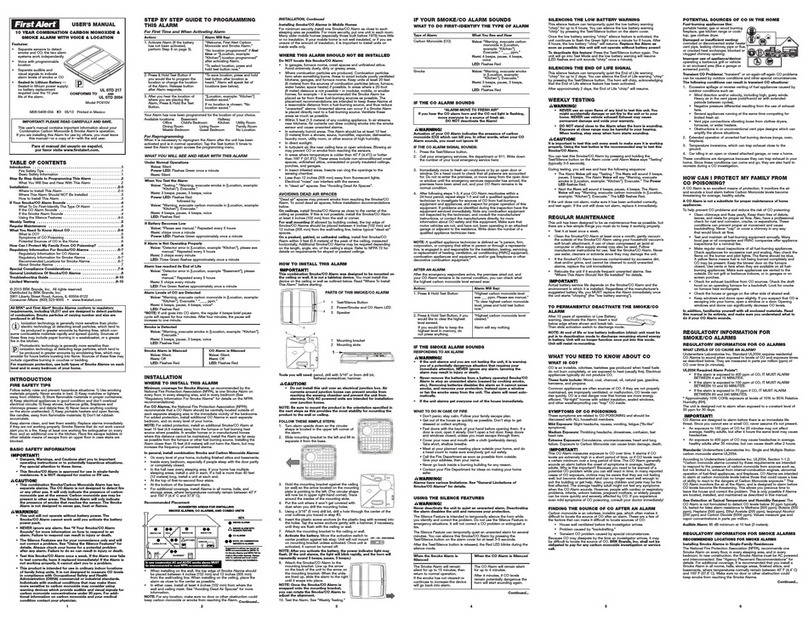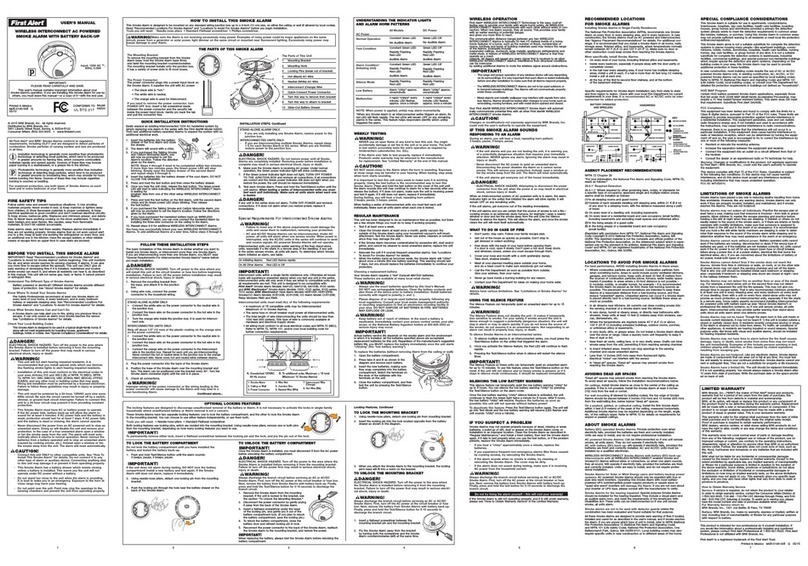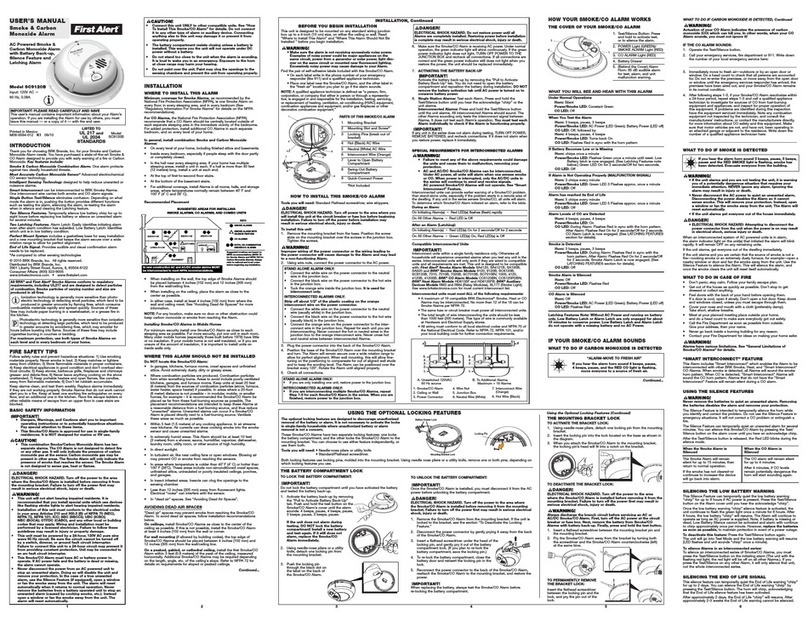7 8
Printed in Mexico M08-0094-024 K1 08/12
BRK Electronics®is a registered trademark of BRK Brands, Inc.
First Alert®is a registered trademark of the First Alert Trust.
9 10 11 12
WEEKLY TESTING
• NEVER use an open flame of any kin to test this unit. You
might acci entally amage or set fire to the unit or to your
home. The built-in test switch accurately tests the unit’s
operation as require by Un erwriters Laboratories, Inc.
(UL). NEVER use vehicle exhaust! Exhaust may cause per-
manent amage an voi s your warranty.
• DO NOT stan close to the Alarm when the horn is soun ing.
Exposure at close range may be harmful to your hearing.
When testing, step away when horn starts soun ing.
It is important to test this unit every week to make sure it is working
properly. Using the test button is the recommen e way to test this
Smoke/CO Alarm.
1. Push and hold the Test/Silence button on the cover until you hear a
“chirp.” The “chirp” marks the start of the self-test sequence.
2. During testing, you will hear a loud, repeating horn pattern 3 beeps,
pause, 3 beeps, pause, while the red smoke LED flashes. Then you
will hear a loud, repeating horn pattern 4 beeps, pause, 4 beeps,
pause, while the red CO LED flashes.
3. When testing a series of interconnected units you must test each
unit individually. Make sure all units alarm when each one is tested.
If the Smoke/CO Alarm oes not test properly:
1. Make sure the AC power is applied and battery is fresh and
installed correctly.
2. Be sure the alarm is clean and dust-free.
3. Test the unit again.
If the Smoke/CO Alarm is still not working properly, replace it immediately.
Refer to the “Limited Warranty” at the end of this manual.
If there is still a problem, o not try to fix the Alarm yourself.
This will voi your warranty!
REGULAR MAINTENANCE
This unit has been designed to be as maintenance-free as possible, but
there are a few simple things you must do to keep it working properly
• Test it at least once a week.
•Clean the Smoke/CO Alarm at least once a month; gently vacuum
the outside of the Smoke/CO Alarm using your household vacuum’s
soft brush attachment. Test the Smoke/CO Alarm. Never use water,
cleaners or solvents since they may damage the unit.
• If the Smoke/CO Alarm becomes contaminated by excessive dirt,
dust and/or grime, and cannot be cleaned to avoid unwanted
alarms, replace the unit immediately.
• Relocate the unit if it sounds frequent unwanted alarms. See “Where
This Alarm Should Not Be Installed” for details.
•When the battery back-up becomes weak, the Alarm will “chirp”
about once a minute (the low battery warning). This warning should
last 7 days, but you should replace the battery immediately to
continue your protection. This Alarm must have AC or battery
power to operate. If AC power fails, an the battery is ea
or missing, the Alarm cannot operate.
DO NOT spray cleaning chemicals or insect sprays irectly on or near
the Alarm. DO NOT paint over the Alarm. Doing so may permanently
amage the Alarm.
CHOOSING A REPLACEMENT BATTERY:
This Smoke/CO Alarm requires one standard 9V alkaline battery. The
following alkaline batteries are acceptable as replacements Duracell
#MN1604 or MX1604; Eveready “Energizer” 522. You can also use an
Ultralife 9V lithium battery U9VL-J, U9VL-J-P for longer service life
between battery changes. These batteries are available at many
local retail stores.
• Always use the exact batteries specifie by this User’s Manual.
DO NOT use rechargeable batteries. Clean the battery contacts
an also those of the evice prior to battery installation. Install
batteries correctly with regar to polarity (+ an -).
• Please ispose of or recycle use batteries properly, following
any local regulations. Consult your local waste management
authority or recycling organization to fin an electronics
recycling facility in your area. DO NOT DISPOSE OF BATTERIES
IN FIRE. BATTERIES MAY EXPLODE OR LEAK.
• Keep battery out of reach of chil ren. In the event a battery
is swallowe , imme iately contact your poison control center,
your physician, or the National Battery Ingestion hotline at
202-625-3333 as serious injury may occur.
Actual battery service life depends on the Smoke/CO Alarm and the
environment in which it is installed. All the batteries specified above
are acceptable replacement batteries for this unit. Regardless of the
manufacturer’s suggested battery life, you MUST replace the battery
immediately once the unit starts “chirping” (the “low battery warning”).
WHAT YOU NEED TO KNOW ABOUT CO
WHAT IS CO?
CO is an invisible, odorless, tasteless gas produced when fossil fuels
do not burn completely, or are exposed to heat (usually fire). Electrical
appliances typically do not produce CO.
These fuels inclu e: Wood, coal, charcoal, oil, natural gas, gasoline,
kerosene, and propane.
Common appliances are often sources of CO. If they are not properly
maintained, are improperly ventilated, or malfunction, CO levels can rise
quickly. CO is a real danger now that homes are more energy efficient.
“Air-tight” homes with added insulation, sealed windows, and other
weatherproofing can “trap” CO inside.
SYMPTOMS OF CO POISONING
These symptoms are related to CO POISONING and should be
discussed with ALL household members.
Mil Exposure: Slight headache, nausea, vomiting, fatigue (“flu-like”
symptoms).
Me ium Exposure: Throbbing headache, drowsiness, confusion, fast
heart rate.
Extreme Exposure: Convulsions, unconsciousness, heart and lung
failure. Exposure to Carbon Monoxide can cause brain damage, death.
This CO Alarm measures exposure to CO over time. It alarms if CO
levels are extremely high in a short period of time, or if CO levels reach
a certain minimum over a long period of time. The CO Alarm generally
sounds an alarm before the onset of symptoms in average, healthy adults.
Continued...
POTENTIAL SOURCES OF CO IN THE HOME
Fuel-burning appliances
like: portable heater,
gas or wood burning
fireplace, gas kitchen
range or cooktop, gas
clothes dryer.
Damage or insufficient
venting: corroded or
disconnected water
heater vent pipe, leaking
chimney pipe or flue, or
cracked heat exchanger,
blocked or clogged
chimney opening.
Improper use of appliance/ evice: operating a barbecue grill or
vehicle in an enclosed area (like a garage or screened porch).
Transient CO Problems: “transient” or on-again-off-again CO problems
can be caused by outdoor conditions and other special circumstances.
The following con itions can result in transient CO situations:
1. Excessive spillage or reverse venting of fuel appliances caused by
outdoor conditions such as
• Wind direction and/or velocity, including high, gusty winds. Heavy
air in the vent pipes (cold/humid air with extended periods
between cycles).
• Negative pressure differential resulting from the use of exhaust
fans.
• Several appliances running at the same time competing for limited
fresh air.
• Vent pipe connections vibrating loose from clothes dryers,
furnaces, or water heaters.
• Obstructions in or unconventional vent pipe designs which can
amplify the above situations.
2. Extended operation of unvented fuel burning devices (range, oven,
fireplace).
3. Temperature inversions, which can trap exhaust close to the ground.
4. Car idling in an open or closed attached garage, or near a home.
These conditions are dangerous because they can trap exhaust in your
home. Since these conditions can come and go, they are also hard to
recreate during a CO investigation.
HOW CAN I PROTECT MY FAMILY FROM CO
POISONING?
A CO Alarm is an excellent means of protection. It monitors the air
and sounds a loud alarm before Carbon Monoxide levels become
threatening for average, healthy adults.
A CO Alarm is not a substitute for proper maintenance of home
appliances.
To help prevent CO problems and reduce the risk of CO poisoning
• Clean chimneys and flues yearly. Keep them free of debris, leaves,
and nests for proper air flow. Also, have a professional check for
rust and corrosion, cracks, or separations. These conditions can
prevent proper air movement and cause backdrafting. Never “cap”
or cover a chimney in any way that would block air flow.
• Test and maintain all fuel-burning equipment annually. Many local
gas or oil companies and HVAC companies offer appliance
inspections for a nominal fee.
• Make regular visual inspections of all fuel-burning appliances.
Check appliances for excessive rust and scaling. Also check the
flame on the burner and pilot lights. The flame should be blue.
A yellow flame means fuel is not being burned completely and
CO may be present. Keep the blower door on the furnace closed.
Use vents or fans when they are available on all fuel-burning
appliances. Make sure appliances are vented to the outside. Do
not grill or barbecue indoors, or in garages or on screen porches.
• Check for exhaust backflow from CO sources. Check the draft
hood on an operating furnace for a backdraft. Look for cracks on
furnace heat exchangers.
• Check the house or garage on the other side of shared wall.
• Keep windows and doors open slightly. If you suspect that CO
is escaping into your home, open a window or a door. Opening
windows and doors can significantly decrease CO levels.
In a ition, familiarize yourself with all enclose materials. Rea
this manual in its entirety, an make sure you un erstan what to
o if your CO Alarm soun s.
REGULATORY INFORMATION FOR
SMOKE/CO ALARMS
REGULATORY
INFORMATION FOR CO ALARMS
WHAT LEVELS OF CO CAUSE AN ALARM?
Underwriters Laboratories Inc. Standard UL2034 requires residential CO
Alarms to sound when exposed to levels of CO and exposure times as
described below. They are measured in parts per million (ppm) of CO
over time (in minutes).
UL2034 Require Alarm Points*:
• If the alarm is exposed to 400 ppm of CO, IT MUST ALARM
BETWEEN 4 and 15 MINUTES.
• If the alarm is exposed to 150 ppm of CO, IT MUST ALARM
BETWEEN 10 and 50 MINUTES.
• If the alarm is exposed to 70 ppm if CO, IT MUST ALARM
BETWEEN 60 and 240 MINUTES.
*Approximately 10% COHb exposure at levels of 10% to 95% Relative
Humidity (RH).
The unit is designed not to alarm when exposed to a constant level
of 30 ppm for 30 days.
CO Alarms are designed to alarm before there is an immediate life threat.
Since you cannot see or smell CO, never assume it’s not present.
• An exposure to 100 ppm of CO for 20 minutes may not affect
average, healthy adults, but after 4 hours the same level may
cause headaches.
• An exposure to 400 ppm of CO may cause headaches in average,
healthy adults after 35 minutes, but can cause death after 2 hours.
Stan ar s: Underwriters Laboratories Inc. Single and Multiple Station
carbon monoxide alarms UL2034.
According to Underwriters Laboratories Inc. UL2034, Section 1-1.2
“Carbon monoxide alarms covered by these requirements are intended
to respond to the presence of carbon monoxide from sources such as,
but not limited to, exhaust from internal-combustion engines, abnormal
operation of fuel-fired appliances, and fireplaces. CO Alarms are
intended to alarm at carbon monoxide levels below those that could
cause a loss of ability to react to the dangers of Carbon Monoxide
exposure.” This CO Alarm monitors the air at the Alarm, and is
designed to alarm before CO levels become life threatening. This
allows you precious time to leave the house and correct the problem.
This is only possible if Alarms are located, installed, and maintained as
described in this manual.
Gas Detection at Typical Temperature an Humi ity Ranges: The CO
Alarm is not formulated to detect CO levels below 30 ppm typically.
Au ible Alarm: 85 dB minimum at 10 feet (3 meters).
ABOUT SMOKE ALARMS
Battery (DC) operate Smoke Alarms: Provide protection even when
electricity fails, provided the batteries are fresh and correctly installed.
Units are easy to install, and do not require professional installation.
However, they do not provide interconnected functionality.
AC powere Smoke Alarms: Can be interconnected so if one unit
senses smoke, all units alarm. They do not operate if electricity fails.
AC with battery (DC) back-up: will operate if electricity fails, provided
the batteries are fresh and correctly installed. AC and AC/DC units
must be installed by a qualified electrician.
Wireless Interconnecte Alarms: Offer the same interconnected
functionality as with hardwired alarms, without wires. Units are easy
to install and do not require professional installation. They provide
protection even when electricity fails, provided the batteries are fresh
and correctly installed.
Smoke Alarms for Solar or Win Energy users an battery backup
power systems: AC powered Smoke Alarms should only be operated
with true or pure sine wave inverters. Operating this Smoke Alarm with
most battery-powered UPS (uninterruptible power supply) products or
square wave or “quasi sine wave” inverters will amage the Alarm.
If you are not sure about your inverter or UPS type, please consult with
the manufacturer to verify.
Smoke Alarms for the hearing impaire : Special purpose Smoke
Alarms should be installed for the hearing impaired. They include a
visual alarm and an audible alarm horn, and meet the requirements of
the Americans With Disabilities Act. These units can be interconnected
so if one unit senses smoke, all units alarm.
Smoke alarms are not to be use with etector guar s unless the
combination has been evaluated and found suitable for that purpose.
All these Smoke Alarms are designed to provide early warning of fires
if located, installed and cared for as described in the user’s manual,
and if smoke reaches the Alarm. If you are unsure which type of unit to
install, refer to NFPA (National Fire Protection Association) 72 (National
Fire Alarm and Signaling Code) and NFPA 101 (Life Safety Code).
National Fire Protection Association, One Batterymarch Park, Quincy,
MA 02269-9101. Local building codes may also require specific units
in new construction or in different areas of the home.
SPECIAL COMPLIANCE CONSIDERATIONS
This Smoke Alarm is suitable for use in apartments, condominiums,
townhouses, hospitals, day care facilities, health care facilities, boarding
houses, group homes and dormitories provided a primary fire detection
system already exists to meet fire detection requirements in common
areas like lobbies, hallways, or porches. Using this Smoke Alarm in
common areas may not provide sufficient warning to all residents or
meet local fire protection ordinances/regulations.
This Smoke Alarm alone is not a suitable substitute for complete fire
detection systems in places housing many people—like apartment
buildings, condominiums, hotels, motels, dormitories, hospitals, health
care facilities, nursing homes, day care facilities, or group homes of any
kind. It is not a suitable substitute for complete fire detection systems
in warehouses, industrial facilities, commercial buildings, and special-
purpose non-residential buildings which require special fire detection
and alarm systems. Depending on the building codes in your area, this
Smoke Alarm may be used to provide additional protection in these
facilities.
In new construction, most building codes require the use of AC or
AC/DC powered Smoke Alarms only. In existing construction, AC,
AC/DC, or DC powered Smoke Alarms can be used as specified by
local building codes. Refer to NFPA 72 (National Fire Alarm and
Signaling Code) and NFPA 101 (Life Safety Code), local building codes,
or consult your Fire Department for detailed fire protection requirements
in buildings not defined as “households”.
LIMITED WARRANTY
BRK Brands, Inc., ("BRK") the maker of BRK®brand and First Alert®brand products, warrants that for a period of seven years from the date of purchase,
this product will be free from defects in material and workmanship. BRK, at its option, will repair or replace this product or any component of the product
found to be defective during the warranty period. Replacement will be made with a new or remanufactured product or component. If the product is no
longer available, replacement may be made with a similar product of equal or greater value. This is your exclusive warranty.
This warranty is valid for the original retail purchaser from the date of initial retail purchase and is not transferable. Keep the original sales receipt.
Proof of purchase is required to obtain warranty performance. BRK dealers, service centers, or retail stores selling BRK products do not have the right to
alter, modify or any way change the terms and conditions of this warranty.
This warranty does not cover normal wear of parts or damage resulting from any of the following negligent use or misuse of the product, use on improper
voltage or current, use contrary to the operating instructions, disassembly, repair or alteration by anyone other than BRK or an authorized service center.
Further, the warranty does not cover Acts of God, such as fire, flood, hurricanes and tornadoes or any batteries that are included with this unit.
BRK shall not be liable for any incidental or consequential damages caused by the breach of any express or implied warranty. Except to the extent
prohibited by applicable law, any implied warranty of merchantability or fitness for a particular purpose is limited in duration to the duration of the above
warranty. Some states, provinces or jurisdictions do not allow the exclusion or limitation of incidental or consequential damages or limitations on how long
an implied warranty lasts, so the above limitations or exclusion may not apply to you. This warranty gives you specific legal rights, and you may also have
other rights that vary from state to state or province to province.
How to Obtain Warranty Service
Service: If service is required, do not return the product to your retailer. In order to obtain warranty service, contact the Consumer Affairs Division at
1-800-323-9005, 7 30 AM - 5 00 PM Central Standard Time, Monday through Friday. To assist us in serving you, please have the model number and
date of purchase available when calling.
For Warranty Service return to: BRK Brands, Inc., 25 Spur Drive, El Paso, TX 79906
Battery: BRK Brands, Inc. make no warranty, express or implied, written or oral, including that of merchantability or fitness for any particular purpose
with respect to battery.
Once a minute, the alarm sounds 3 “chirps”,
and the green light flashes quickly three times. MALFUNCTION SIGNAL. Unit needs to be
replaced. Based on self-diagnostic tests, the
unit has detected a fault.
Units under warranty should be returned to
manufacturer for replacement. See “Limited
Warranty” for details.
The light flashes (GREEN) and the horn sounds
5 “chirps” every minute. END OF LIFE SIGNAL.
CO Alarm needs to be replaced. Immediately replace the CO Alarm.
Horn "chirps" about once per minute;
Green "Power/Smoke" LED flashes Green On
for 2 seconds/Off for 2 seconds. (Low Battery
Latch is engaged.)
Low battery warning. Battery is low or missing. Replace the battery, avoid interrupting AC
power.
If your Alarm oes this... It means... You shoul ...
Green light is OFF. Unit will not alarm when you
press the Test/Silence button. Unit may not be receiving any power.
Check the AC power supply. Make sure the
power connector is securely attached to the
alarm. Make sure a fresh 9V battery is installed
to power the battery back-up*.
Green light flashes ON, once a minute (horn is
silent).
Alarm is not receiving AC power.
Unit is operating on battery back-up.
Check the AC power supply.
TROUBLESHOOTING GUIDE
Alarm goes back into alarm after you pressed
the Test/Silence button to silence an alarm. Smoke and/or CO levels are still potentially
dangerous. Refer to “If Your Smoke/CO Alarm Sounds” for
details on how to respond to an alarm. If anyone
is feeling ill, EVACUATE your home immediately
and call 911.
If you have any questions that cannot be answered by reading this manual, call Consumer Affairs 1-800-323-9005.
*For a list of acceptable replacement batteries, see “Regular Maintenance.”
Alarm sounds frequently even though no high
levels of smoke or CO are revealed in an
investigation.
The Alarm may be improperly located. Refer to
“Where to Install This Alarm.” Relocate your alarm. If frequent alarms continue,
have home rechecked for potential problems.
You may be experiencing an intermittent smoke
or CO problem.
ELECTRICAL SHOCK HAZARD. Turn off the power to the area where the Alarm is installe BEFORE removing it from the mounting bracket or
checking any electrical connections! Failure to turn off the power first may result in serious electrical shock, injury or eath.
For your recor s, please recor :
Date Purchase : _______________________________
Where Purchase : __________________________________________
Date Installe : ____________/____________Month/Year
Replace alarm 7 years after installation. Please write the ate in
the space provi e : _____________/____________Month/Year
The alarm will also provi e an au ible En -of-Life Signal
approximately 7 years after installation to remin you to
replace the unit.
The En -of-Life Signal can be silence for up to 2 ays.
Do not unplug the alarm or remove the batteries until you get
replacement.
TABLE OF CONTENTS
Intro uction . . . . . . . . . . . . . . . . . . . . . . . . . . . . . . . . . . . . . . . . . . . . . . .1
Fire Safety Tips . . . . . . . . . . . . . . . . . . . . . . . . . . . . . . . . . . . . . . . . . .1-2
Installation . . . . . . . . . . . . . . . . . . . . . . . . . . . . . . . . . . . . . . . . . . . . .2-4
Where To Install This Alarm . . . . . . . . . . . . . . . . . . . . . . . . . . . . . . . .2
Where This Alarm Should Not Be Installed . . . . . . . . . . . . . . . . . . . .2
Before You Begin Installation . . . . . . . . . . . . . . . . . . . . . . . . . . . . . . .3
How To Install This Smoke/CO Alarm . . . . . . . . . . . . . . . . . . . . . .3-4
Using the Optional Locking Features . . . . . . . . . . . . . . . . . . . . . . .3-5
How Your Smoke/CO Alarm Works . . . . . . . . . . . . . . . . . . . . . . . . . .5
What You Will See an Hear With This Alarm . . . . . . . . . . . . . . . . . .5
If Your Smoke/CO Alarm Soun s . . . . . . . . . . . . . . . . . . . . . . . . . .5-7
What To Do If CO is Detected . . . . . . . . . . . . . . . . . . . . . . . . . . . .5-6
What To Do If Smoke is Detected . . . . . . . . . . . . . . . . . . . . . . . . . . .6
“Smart Interconnect” Feature . . . . . . . . . . . . . . . . . . . . . . . . . . . . . .6
Using the Silence Features . . . . . . . . . . . . . . . . . . . . . . . . . . . . . . . .6
Latching Features . . . . . . . . . . . . . . . . . . . . . . . . . . . . . . . . . . . . . . . .7
Weekly Testing . . . . . . . . . . . . . . . . . . . . . . . . . . . . . . . . . . . . . . . . . . .7
Regular Maintenance . . . . . . . . . . . . . . . . . . . . . . . . . . . . . . . . . . . . . .7
What You Nee To Know About CO . . . . . . . . . . . . . . . . . . . . . . . . .7-8
What is CO? . . . . . . . . . . . . . . . . . . . . . . . . . . . . . . . . . . . . . . . . . . . .7
Symptoms of CO Poisoning . . . . . . . . . . . . . . . . . . . . . . . . . . . . . .7-8
Finding the Source of CO After an Alarm . . . . . . . . . . . . . . . . . . . . .8
Potential Sources of CO in the Home . . . . . . . . . . . . . . . . . . . . . . . .8
How Can I Protect My Family From CO Poisoning? . . . . . . . . . . . . .8
Regulatory Information For Smoke/CO Alarms . . . . . . . . . . . . . .8-10
Regulatory Information for CO Alarms . . . . . . . . . . . . . . . . . . . . . . .8
Regulatory Information for Smoke Alarms . . . . . . . . . . . . . . . . . . . .9
About Smoke Alarms . . . . . . . . . . . . . . . . . . . . . . . . . . . . . . . . . . . . .9
Special Compliance Considerations . . . . . . . . . . . . . . . . . . . . . . .10
General Limitations Of Smoke/CO Alarms . . . . . . . . . . . . . . . . . . .10
Troubleshooting Gui e . . . . . . . . . . . . . . . . . . . . . . . . . . . . . . . . .11-12
Limite Warranty . . . . . . . . . . . . . . . . . . . . . . . . . . . . . . . . . . . . . .11-12
GENERAL LIMITATIONS OF SMOKE/CO ALARMS
This Smoke/CO Alarm is intended for residential use. It is not intended
for use in industrial applications where Occupational Safety and Health
Administration (OSHA) requirements for Carbon Monoxide Alarms must
be met. The Smoke Alarm portion of this device is not intended to alert
hearing impaired residents. Special purpose Smoke Alarms should be
installed for hearing impaired residents (CO Alarms are not yet available
for the hearing impaired).
Smoke/CO Alarms may not waken all in ivi uals. Practice the
escape plan at least twice a year, making sure that everyone is involved
– from kids to grandparents. Allow children to master fire escape
planning and practice before holding a fire drill at night when they are
sleeping. If children or others do not readily waken to the sound of the
Smoke/CO Alarm, or if there are infants or family members with mobility
limitations, make sure that someone is assigned to assist them in fire
drill and in the event of an emergency. It is recommended that you hold
a fire drill while family members are sleeping in order to determine their
response to the sound of the Smoke/CO Alarm while sleeping and
to determine whether they may need assistance in the event of an
emergency.
Smoke
/CO
Alarms cannot work without power. Battery operated units
cannot work if the batteries are missing, disconnected or dead, if the wrong
type of batteries are used, or if the batteries are not installed correctly.
AC units cannot work if the AC power is cut off for any reason (open fuse
or circuit breaker, failure along a power line or at a power station, electrical
fire that burns the electrical wires, etc.). If you are concerned about the
limitations of battery or AC power, install both types of units.
This Smoke/CO Alarm will not sense smoke or CO that oes not
reach the sensors. It will only sense smoke or CO at the sensor. Smoke
or CO may be present in other areas. Doors or other obstructions may
affect the rate at which CO or smoke reaches the sensors. If bedroom
doors are usually closed at night, we recommend you install an alarm
device (Combination CO and Smoke Alarm, or separate CO Alarms and
Smoke Alarms) in each bedroom and in the hallway between them.
This Smoke/CO Alarm may not sense smoke or CO on another
level of the home. Example This alarm device, installed on the second
floor, may not sense smoke or CO in the basement. For this reason,
one alarm device may not give adequate early warning. Recommended
minimum protection is one alarm device in every sleeping area, every
bedroom, and on every level of your home. Some experts recommend
battery powered Smoke and CO Alarms be used in conjunction with
interconnected AC powered Smoke Alarms. For details, see “About
Smoke Alarms” for details.
Smoke/CO Alarms may not be hear . The alarm horn loudness
meets or exceeds current UL standards of 85 dB at 10 feet (3 meters).
However, if the Smoke/CO Alarm is installed outside the bedroom, it
may not wake up a sound sleeper or one who has recently used drugs
or has been drinking alcoholic beverages. This is especially true if the
door is closed or only partly open. Even persons who are awake may
not hear the alarm horn if the sound is blocked by distance or closed
doors. Noise from traffic, stereo, radio, television, air conditioner, or
other appliances may also prevent alert persons from hearing the alarm
horn. This Smoke/CO Alarm is not intended for people who are hearing
impaired.
The Alarm may not have time to alarm before the fire itself causes
amage, injury, or eath, since smoke from some fires may not
reach the unit imme iately. Examples of this inclu e persons
smoking in be , chil ren playing with matches, or fires cause
by violent explosions resulting from escaping gas.
This Smoke/CO Alarm is not a substitute for life insurance.
Though this Smoke/CO Alarm warns against increasing CO levels or
the presence of smoke, BRK Brands, Inc. does not warrant or imply in
any way that they will protect lives. Homeowners and renters must still
insure their lives.
This Smoke/CO Alarm has a limite life. Although this Smoke/CO
Alarm and all of its parts have passed many stringent tests and are
designed to be as reliable as possible, any of these parts could fail at
any time. Therefore, you must test this device weekly. The unit should
be replaced immediately if it is not operating properly.
This Smoke/CO Alarm is not foolproof. Like all other electronic
devices, this Smoke/CO Alarm has limitations. It can only detect smoke
or CO that reaches the sensors. It may not give early warning of the
source of smoke or CO is in a remote part of the home, away from the
alarm device.
LATCHING FEATURES
Alarm Latch is activated after an Alarm is exposed to alarm levels of
smoke or carbon monoxide. After smoke or CO levels drop below alarm
levels, the “Smoke/Power” or “CO” Red LED will begin to flash On 2
seconds/Off 2 seconds. It will continue to flash or “latch” until you clear
it by testing the alarm.
This feature helps emergency responders,
investigators, or service technicians identify which unit(s) in your home
were exposed to alarm levels of smoke or carbon monoxide. This can
help investigators pinpoint the source of smoke or CO.
Interconnecte Alarms. Latching Alarm Indicator shows which Alarm(s)
in the series were exposed to alarm levels of smoke or carbon monoxide.
The Latching Alarm Indicator stays ON until you clear it, so it can alert
you to an alarm that occurred while you were away from home, even
though smoke or CO present in the air has dropped below alarm levels.
Low Battery Latch is activated when the Alarm is in the "low battery
condition". When this occurs, the Smoke/Power LED flashes Green On
for 2 seconds/Off for 2 seconds. This feature is designed to help you
identify which Alarm needs to have the battery replaced. Although, the
Alarm will sound the low battery chirp approximately once every minute,
sometimes during the initial stages of "low battery", the Alarm will chirp
in greater intervals than one minute, sometimes up to several hours, until
the battery reaches a steady low battery level. This innovative feature
eliminates the frustration of waiting for and/or identifying which unit is
chirping.
Latching Features Note: Without AC Power an running on battery
only, Low Battery Latch or Alarm Latch are only engage for about
15 minutes to conserve power. Low Battery Latch an Alarm Latch
o not operate with a missing battery an no AC Power.
IF YOUR SMOKE/CO ALARM SOUNDS, Continued SYMPTOMS OF CO POISONING, Continued
Why is this important? Because you need to be warned of a potential
CO problem while you can still react in time. In many reported cases of
CO exposure, victims may be aware that they are not feeling well, but
become disoriented and can no longer react well enough to exit the
building or get help. Also, young children and pets may be the first
affected. The average healthy adult might not feel any symptoms when
the CO Alarm sounds. However, people with cardiac or respiratory
problems, infants, unborn babies, pregnant mothers, or elderly people
can be more quickly and severely affected by CO. If you experience
even mild symptoms of CO poisoning, consult your doctor immediately!
FINDING THE SOURCE OF CO AFTER AN ALARM
Carbon monoxide is an odorless, invisible gas, which often makes it
difficult to locate the source of CO after an alarm. These are a few of
the factors that can make it difficult to locate sources of CO
• House well ventilated before the investigator arrives.
• Problem caused by “backdrafting.”
• Transient CO problem caused by special circumstances.
Because CO may dissipate by the time an investigator arrives, it may
be difficult to locate the source of CO. BRK Bran s, Inc. shall not be
obligate to pay for any carbon monoxi e investigation or service
call.
REGULATORY INFORMATION FOR SMOKE ALARMS
RECOMMENDED LOCATIONS FOR SMOKE ALARMS
Installing Smoke Alarms in Single-Family Resi ences
The National Fire Protection Association (NFPA), recommends one
Smoke Alarm on every floor, in every sleeping area, and in every bed-
room. In new construction, the Smoke Alarms must be AC powered and
interconnected. See “Agency Placement Recommendations” for details.
For additional coverage, it is recommended that you install a Smoke
Alarm in all rooms, halls, storage areas, finished attics, and basements,
where temperatures normally remain between 40˚ F (4.4˚ C) and 100˚ F
(37.8˚ C). Make sure no door or other obstruction could keep smoke
from reaching the Smoke Alarms.
More specifically, install Smoke Alarms:
•On every level of your home, including finished attics and basements.
• Inside every bedroom, especially if people sleep with the door partly
or completely closed.
• In the hall near every sleeping area. If your home has multiple
sleeping areas, install a unit in each. If a hall is more than 40 feet
long (12 meters), install a unit at each end.
• At the top of the first-to-second floor stairway, and at the bottom of
the basement stairway.
Specific requirements for Smoke Alarm installation vary from state to
state and from region to region. Check with your local Fire Department
for current requirements in your area. It is recommen e AC or AC/DC
units be interconnecte for a e protection.
AGENCY PLACEMENT RECOMMENDATIONS
Stan ar s: Underwriters Laboratories Inc. Single and Multiple Station
Smoke Alarms 217.
NFPA 72 Chapter 29
“For your information, the National Fire Alarm an Signaling Co e,
NFPA 72, reads as follows ”
29.5.1* Require Detection.
29.5.1.1* Where required by other governing laws, codes, or standards
for a specific type of occupancy, approved single and multiple-station
smoke alarms shall be installed as follows
(1)*In all sleeping rooms and guest rooms
(2)*Outside of each separate dwelling unit sleeping area, within 21 ft
(6.4 m) of any door to a sleeping room, with the distance measured
along a path of travel
(3) On every level of a dwelling unit, including basements
(4) On every level of a residential board and care occupancy (small
facility), including basements and excluding crawl spaces and
unfinished attics
(5)*In the living area(s) of a guest suite
(6) In the living area(s) of a residential board and care occupancy
(small facility)
(Reprinted with permission from NFPA 72®, National Fire Alarm and
Signaling Code Copyright © 2010 National Fire Protection Association,
Quincy, MA 02269. This reprinted material is not the complete and
official position of the National Fire Protection Association, on the
referenced subject which is represented only by the standard in its
entirety), (National Fire Alarm and Signaling Code®and NFPA 72®are
registered trademarks of the National Fire Protection Association, Inc.,
Quincy, MA 02269).
California State Fire Marshal (CSFM)
Early warning detection is best achieved by the installation of fire
detection equipment in all rooms and areas of the household as follows
A Smoke Alarm installed in each separate sleeping area (in the vicinity,
but outside bedrooms), and Heat or Smoke Alarms in the living rooms,
dining rooms, bedrooms, kitchens, hallways, finished attics, furnace
rooms, closets, utility and storage rooms, basements, and attached
garages.
FCC Compliance
This equipment has been tested and found to comply with the limits
for a Class B digital device, pursuant to Part 15 of the FCC rules. These
limits are designed to provide reasonable protection against harmful
interference in a residential installation. This equipment generates, uses
and can radiate radio frequency energy and, if not installed and used
in accordance with the instructions, may cause harmful interference to
radio communications.
However, there is no guarantee that the interference will not occur in a
particular installation. If this equipment does cause harmful interference
to radio or television reception, which can be determined by turning
the equipment off and on, the user is encouraged to try to correct the
interference by one or more of the following measures
• Reorient or relocate the receiving antenna.
•Increase the separation between the equipment and receiver.
•Connect the equipment into an outlet on a circuit different from that
of the receiver.
• Consult the dealer or an experienced radio or TV technician for
help.
Warning: Changes or modifications to the product, not expressly
approved by First Alert / BRK Brands, Inc., could void the user’s
authority to operate the equipment.
This device complies with Part 15 of the FCC Rules. Operation is
subject to the following two conditions (1) this device may not cause
harmful interference, and (2) this device must accept any interference
received, including interference that may cause undesired operation.


